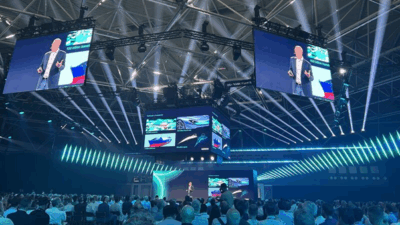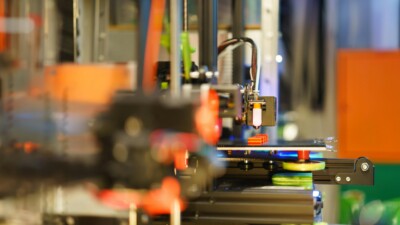Looking back and looking ahead at Hexagon’s latest annual industry event.
Las Vegas is a strange place.
For some, it represents the pinnacle of revelry: it’s where you go for birthdays, bachelor/bachelorette parties, or big celebratory weekends. The food and drink are plentiful and varied. You can’t walk more than a hundred feet without passing a slot machine. Opportunities for indulgence abound. The whole sentiment behind that well worn phrase which begins, “What happens in Vegas…” is an invective to cut loose and succumb to your most debaucherous impulses. It’s basically Bacchanalia 24/7.
Or it’s where you go for industry events.
At this point, I’ve been to Sin City more times than I care to count and I’ve yet to visit for the first reason. Whenever I’m asked if I’m travelling “For business or pleasure?” my answer has always been the former. This year, I came for Hexagon LIVE: one among the hundreds (thousands?) of attendees hosted at the Fontainebleau, the newest hotel on the strip. There were plenty of familiar faces and the usual trade show trappings, but there were also some big surprises and, of course, the food was amazing.
Here’s what I saw.
The world’s most sophisticated measuring tape
The Fontainebleau is a modern casino seeking to evoke the spirit of Old Las Vegas. Black and white photos of icons like Elvis and Sinatra line the walls. The opening night reception took place against a backdrop of live jazz, power bowls, and white-gloved hands holding glasses of champagne through a fake plastic hedge at the back of the room.
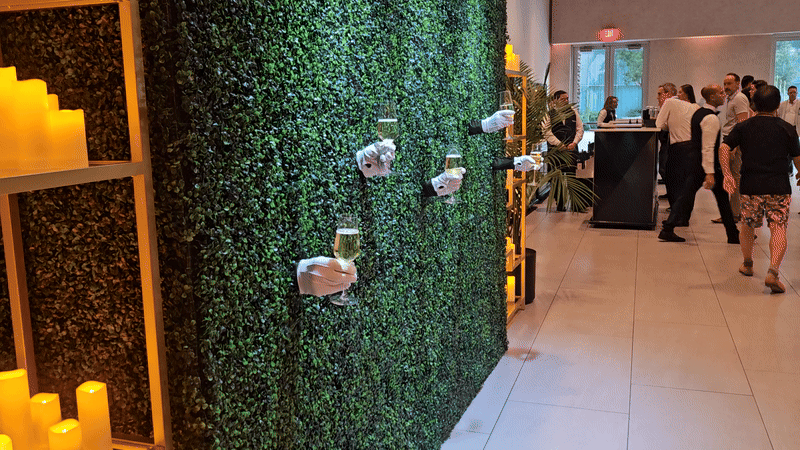
Packs of attendees with matching lanyards and matching looks of confusion streamed along labyrinthine marble corridors, trying to find their way to the reception. More than once over the course of the week, I heard someone in the elevator ask if we really had to traverse the casino to get between the hotel and the conference center.
I assume it was their first time in Vegas.
There’s a certain irony in the juxtaposition of a company that prides itself on precision hosting an event in a city so devoted to excess, but the spectacle of the venue ultimately accorded well with the vision presented in the opening keynote.
Ola Rollén, Hexagon’s former president and CEO and current chairman of its board of directors, took to the stage with his usual brand of laidback charisma, weaving a narrative that mixed the history of measurement – from the cubit and the furlong to the mile and the meter – with the history of his company, starting with its acquisition of Brown & Sharpe in 2000.
He presented the now customary metaphor of building a bridge between digital and physical worlds, buttressed by the idea that Hexagon (or more specifically, what it makes) is “the world’s most sophisticated measuring tape” with examples of coordinate measuring machines (CMMs) that boast sub-micron accuracy and satellite-based systems that can map geographic features from orbit to within a few centimeters.
All of this, while certainly technically impressive, was basically table stakes. But then Rollén made two announcements that I think most of us weren’t expecting.
Octave & AEON
The first was the introduction of a new spin-off built from some of the biggest pieces of Hexagon’s software business. Dubbed Octave, the new company will combine Hexagon’s Asset Lifecycle Intelligence and Safety Infrastructure and Geospatial divisions with ETQ and Bricsys.
The result will be a billion-dollar “start-up” (a sort of pre-fabricated unicorn) with approximately 7,200 employees.
At a time when consolidation is running rampant in virtually every sector, this divestment might seem unusual. Nevertheless, according to Octave’s new CEO, Mattias Stenberg, it’s the right move to make.
“Hexagon is an amazing company,” he said in a press conference. “But it’s also turned into quite a wide monster. So, I think what I and the board and several others have felt over the last couple of years is that it would be a benefit to focus like this. My message to customers is that we’ll have a bigger budget and more autonomy in deciding where to invest.”
The formation of Octave will have an impact in the near term but the second (and arguably more dramatic) announcement was made with an eye to the future. With a theatrical flare, Rollén introduced the world to AEON, Hexagon’s own entry into the rapidly expanding population of humanoid robots.
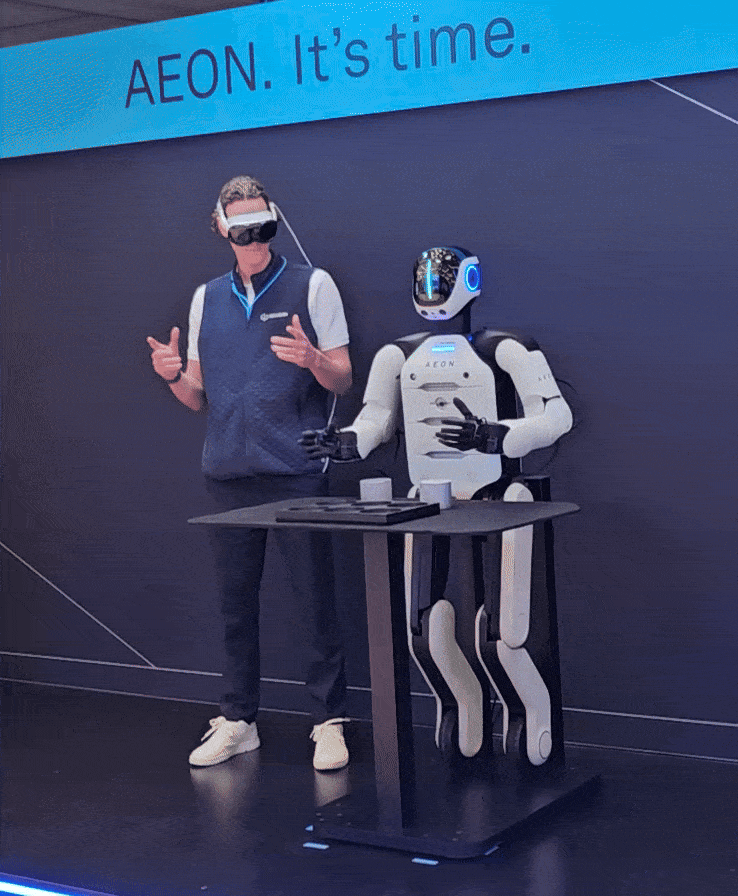
While it may seem an odd choice for Hexagon to get into the robotics game, the move fits with the general enthusiasm for AI that seems to be gripping the industrial tech world. Moreover, Hexagon’s particular expertise in advanced sensor technology – one of the prerequisites for humanoid robotics in particular – makes the company well-positioned to develop a robot of its own, at least according to Rollén.
“Hexagon’s legacy in precision measurement and sensor technologies has always been about enabling next-generation autonomy,” he said. “Hexagon is one of the best-placed companies in the world to lead and shape the field of humanoid robotics.”
It’s hard to say this early on whether AEON will end up going beyond the few pilot projects announced with Schaeffler and Pilatus, but I will note that Rollén’s attempt to shake AEON’s hand as he left the stage was entirely unacknowledged by the machine, suggesting that it’s still a far cry from being able to operate independently.
Unless it was a deliberate slight, in which case we should all be worried.
State of manufacturing
Along with new product announcements and customer use cases, Hexagon LIVE included data from not one but two major surveys from the manufacturing sector. A global survey focused on executive perspectives while a second targeted the US and included insights from entry-level employees as well as management.
The global survey, entitled Advanced Manufacturing Report and conducted by Forrester, includes responses from 1,000 manufacturing executives. The US survey, conducted by Hexagon’s Manufacturing Intelligence division, is not yet available to the general public, but engineering.com got a sneak preview of the results as part of our attendance at Hexagon LIVE. Given that exclusivity, let’s focus on the results of the latter report.
Recent discussions about the prospects for U.S. manufacturing tend to concentrate on two main challenges the sector is facing: tariffs and talent shortages. While the former is a (relatively) novel issue, the latter has been under discussion for decades, going at least as far back as 1998. That’s when the National Skill Standards Board (NSSB) and the National Association of Manufacturers (NAM) began expressing concerns about a skills gap, with NAM stating that nine of its ten member associations were unable to find enough skilled workers to meet their needs.
But here’s one challenge for manufacturing that you might not expect to top the list: outdated technology. Nevertheless, that was one of the major findings of the US report, with 72% of respondents stating that outdated technology is preventing them from attracting and retaining workers. If that’s right, it implies that the underlying cause of the skills gap in manufacturing might not be misperception of the sector – as is often speculated – but a lack of new technology.
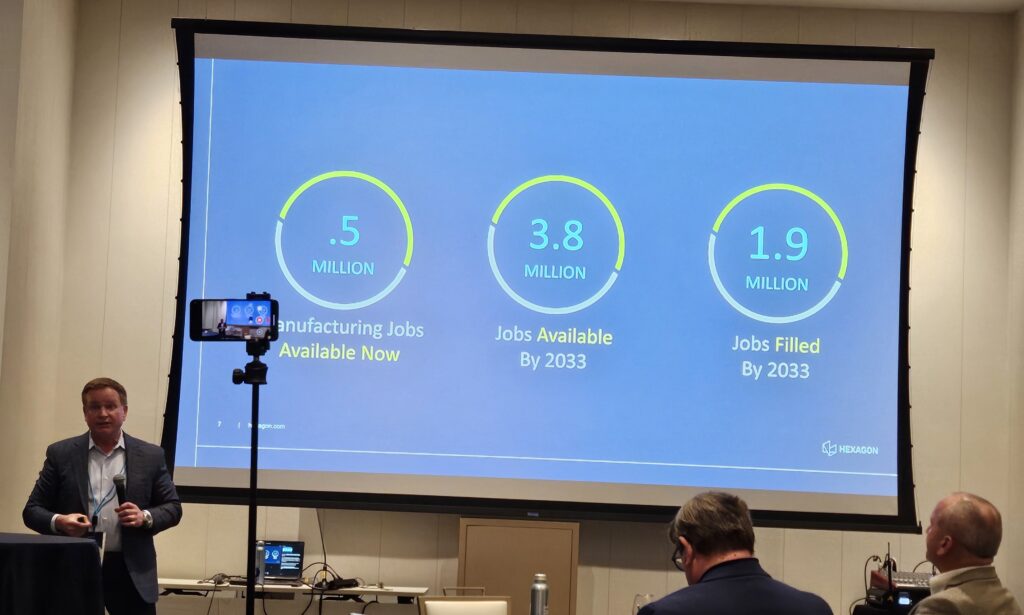
Indeed, other results from the survey appear to support this conclusion, with 60% of respondents reporting that they’re doing enough to make the sector more appealing to new talent. However, there’s also a notable disconnect between executives and entry-level employees regarding the question of whether or not the perception of manufacturing is improving: 86% of executives say it is, while only 59% of entry-level employees agree.
What explains this apparent disagreement?
According to Stephen Graham, executive vice president and general manager of Nexus, Hexagon’s digital reality platform, the cause may be due to a discontinuity between generations.
“I’m not aware of us doing a survey back in 1998,” he said. “But I’ll bet that the perception [of manufacturing] has gotten a lot worse since then because now we have Gen Z coming in, and they’re used to using social media to collaborate on everything. Most manufacturing organizations don’t have technologies that are anything like that.”
Paul Rogers, Hexagon’s president and CEO for the Americas and Asia Pacific, echoed that sentiment in a press event discussing the survey.
“My kids are Gen Z,” he said, “and when you think of what they would identify with manufacturing, it’s dark places with sparks flying, dirty coveralls, things of that nature. But what they’re really expecting is a fully digital environment where everything is high-tech and automated. So, we have to change the perception for Gen Z but, more importantly, we have to change the perspective of the existing workforce and retrain them to think more digital.”
Rogers went on to contrast the user experience with industrial technology with that of consumer tech, where the latter tends to be much more sophisticated and, more importantly, intuitive. “I’ve talked to some major customers and they’re indicating that what they need is for someone to walk in off the street and be ready to go in a few hours,” he said.
Ultimately, this suggests that manufacturing’s perception problem and its technology deficits are interrelated. If that’s right, then both challenges will need to be addressed to deal with the skills gap. The adoption of new, more intuitive tech could help improve the perception of manufacturing – particularly for Gen Z – while more Gen Z members entering the manufacturing workforce could help accelerate that adoption in turn.
Hexagon LIVE 2025
There’s much more to cover from this year’s event, including some incredible stories involving additive manufacturing (stay tuned for those). But, as I headed home, I found myself looking ahead to wonder what next year’s Hexagon LIVE will look like.
Will those white-gloved hands holding champagne be replaced by AEON robots?
Will Octave and its components still be part of The Zone show floor or will the new company have its own event?
Perhaps, most of all, I wondered this: How do you top the announcements of a billion-dollar spin off and a humanoid robot in the same keynote?
I guess I’ll have to wait until next year to find out.
